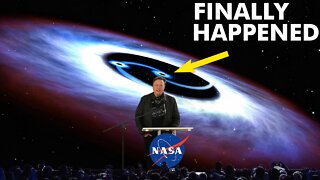Scientists Found a NEW Way to Finally Travel faster than Light!
Mankind Will Soon Be Able to Travel to Other Galaxies - Spaceships Faster than Lightspeed!
In millennia past, people have progressively figured out more effective ways of getting from one place to another. Previously, long distances could only be traversed by horseback or even on foot, but today we have at our disposal a variety of modes of transportation, including cars, planes, trains, and even futuristic ships.
So, while we've already made progress in developing faster and more efficient forms of transportation on Earth, the question now is how manned space flight will evolve in this regard. As is well known, a space probe launched from Earth takes many months, if not years, to reach its galactic target. It's hard to say what the future holds for this venture.
A fascinating question arises when we follow the thought experiment of breaking ever new cosmic speed records to its logical conclusion: Will there ever be light-speed ships? In today's video, we will quickly take a closer look at this fascinating issue with you.
But before we begin, kindly subscribe to this channel, like this video, and enable the notification feature If you haven't already. Come on, let's get started!
Light travels quickly because it has a short path to travel. According to cosmological laws, nothing can move faster than light. In reality, it is the fastest object on the planet. There is no limit to the distance that light may travel; it travels at a speed of 186,000 miles per second. In the blink of an eye, light may travel from Los Angeles to New York City. Faster than any commercial airliner by more than 10,000 orders of magnitude.
Proxima Centauri is the nearest star to Earth. It's 4.25 light-years away, or 25 trillion miles away (40 trillion km). The Parker Solar Probe, which is already in orbit, will achieve a top speed of 450,000 mph, making it the fastest spacecraft ever. At such speed, it would take just 20 seconds to travel from Los Angeles to New York City, yet the solar probe would take 6,633 years to reach Earth's nearest neighboring solar system.
Everything in our Universe is bound by a few simple rules. The conservation of energy, momentum, and angular momentum is guaranteed anytime two quanta come into contact with each other. There are no differences between the physics of a forward-moving system of particles and its mirrored antiparticle counterpart when time is reversed in a mirror. Nothing can ever travel faster than the speed of light, and nothing with mass will ever be able to achieve this coveted feat.
Many people have come up with innovative ways to get around this final restriction. In theory, tachyons have been introduced as hypothetical particles that could theoretically exceed the speed of light, but tachyons must have imaginary masses and do not exist in the real world. Although a sufficiently twisted space in General Relativity could produce other, shorter paths for light, there are no known wormholes in our physical universe. While quantum entanglement can produce "suspicious" behavior at a distance, no information can be transported faster than light.
People will have to go faster than the speed of light if they ever hope to travel effortlessly between stars. However, until now, faster-than-light travel has only existed in science fiction.
In Isaac Asimov's Foundation series, humans can use jump drives to travel between planets, stars, and even the entire cosmos. Interstellar astronauts and Thor heroes exploit wormholes to travel across solar systems in just a few seconds.
Warp drive technology is another option that "Star Trek" fans are familiar with. Theoretically, warp drives are conceivable, but a long way off. One of the many obstacles separating warp drive theory from reality was reported to have been surmounted in two recent studies published in March 2021.
However, how do these speculative warp drives actually operate in reality? As for the future of humankind, will they be able to travel at warp speed?
Albert Einstein's General Relativity theory is the foundation of modern physics' knowledge of spacetime. According to General Relativity, nothing can travel faster than the speed of light in the universe. Mass and energy can also cause spacetime to distort around massive objects, such as stars and black holes. Many space heroes are afraid of "falling into" or "getting stuck in" a gravity well because of this curvature. John Campbell and Isaac Asimov, among the first science fiction writers, regarded warping as a technique to get around the speed limit.
Wouldn't it be cool if a spaceship could shrink the volume of space around it while simultaneously growing the volume behind it? The warp drive from "Star Trek" is based on this concept.
Mexican theoretical physicist Miguel Alcubierre demonstrated in 1994 that compressing spacetime in front of the spacecraft while expanding it behind was mathematically achievable under the laws of General Relativity.
-
 10:47
10:47
Future Space
1 year agoIt's Reality! Astronomers Might've Found First Ever White Hole
45 -
 LIVE
LIVE
The Charlie Kirk Show
44 minutes agoJuly Surprise + Boomers Voting Biden? | Gor, Sen. Tuberville, Baris, Plume | 6.17.24
8,367 watching -
 LIVE
LIVE
Spittin' Chiclets
2 hours agoSpittin’ Chiclets Episode 508: Game 4 Recap
415 watching -
 DVR
DVR
The Dan Bongino Show
2 hours agoYes! This Is How We Fight Back (Ep. 2273) - 06/18/2024
125K950 -
 1:45:18
1:45:18
Steven Crowder
3 hours ago🔴 Magical Mystery Faith Healing with Tumor Toucher Cori Bush
115K184 -
 DVR
DVR
Benny Johnson
1 hour agoIT'S HAPPENING: The PLOT To REPLACE Joe Biden Has Been Put Into ACTION | DNC In Panic As Trump ROLLS
6.74K32 -
 25:04
25:04
Breaking Points
2 hours ago6/18/24: LIVE AMA!
7.3K5 -
 LIVE
LIVE
jeffahern
1 hour agoTrending Tuesday With Jeff Ahern (9am Pacific)
155 watching -
 9:45
9:45
Dr Steve Turley
1 hour agoIT’S OVER! Reports Coming Out Biden Will Be REPLACED!!!
1.02K15 -
 1:12:04
1:12:04
Graham Allen
4 hours agoREVEALED: Plan To REPLACE Biden! + US on high alert for terror threat!
35.1K79